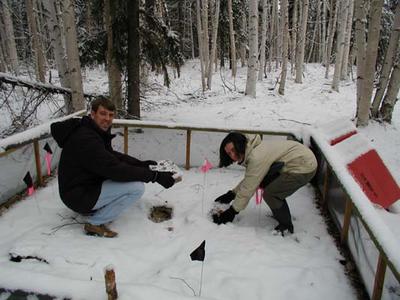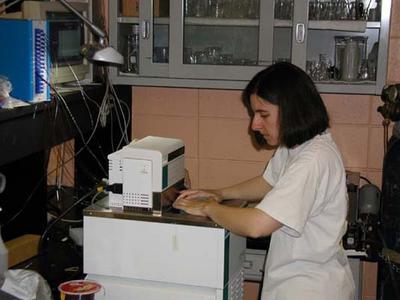2 May, 2002
I woke up to snow this morning. A small storm system moved in overnight and
left us with a couple of inches of wet snow on the ground. The snow ended
about 10 o'clock this morning and gave way to beautiful clear blue skies.
Actually the first clear skies I have seen since I've been here. Everyone
here seems to think the clearing means that spring has finally arrived. Even
though the temperatures are still in the low forties, short-sleeved shirts
are showing up everywhere. Sometimes the different approaches to attire lead
to some funny scenes. I saw two people standing on a corner at lunchtime. One
was in a parka and boots while the second was wearing shorts and a T-shirt.
"Warm" means something different to everyone I suppose.
Undaunted by the snowfall, we headed back into the hills this morning to
collect more insects. There are a few sites nearby that were set up last
September as test sites. The insects were given an artificial habitat and
left until they could be collected this spring. Our task this morning was to
collect from these sites. The insects at the collection sites are the Cucujus
larva that we have been working with and also a species of Click Beetle. The
Click Beetles are the same species that we will be collecting at the Toolik
Lake site. We want to compare the cold temperature tolerances of the two
different populations.
Once morning collections were completed, we headed back into the lab to
measure the supercooling points of the study insects. The supercooling point
is the temperature at which the fluids inside the insect actually freeze. We
test this by sticking a thermocouple to the back of the insect with special
super secret recipe goo. The insect and attached thermocouple is placed into
a culture tube; the tube is sealed with a foam stopper and then placed into a
super chilled alcohol bath. The temperatures in the bath can go below -40
degrees Celsius. Data is gathered as the thermocouple measures all
temperature changes in the culture tube. Since we cannot actually see the
insect freezing, we must look for some other evidence of freezing. Whenever a
liquid changes state to become a solid, the transition is always accompanied
by a small release of thermal energy. Since a solid is a lower energy form of
matter, the molecules must release that extra, no longer needed energy into
its surroundings. It is this small increase in temperature that we look for.
The very beginning of the thermal energy release is considered to be the
insect's supercooling point. So far we have found that the Cucujus larva have
supercooling points anywhere between -90 and -280 degrees Celcius.
What makes for such a wide variation is one of the questions being
considered in this research.
While I have a chance here today, I wanted to start introducing the other
members of the research team here. Dr. Valerie Bennett is the research
celebrity for today's entry. Val is a postdoctoral fellow at the University
of Notre Dame. She also has some ties to the Cincinnati area. After getting a
bachelor's degree at Colgate University, Valerie got her Master's Degree and
her Ph.D. at Miami University in Oxford. She went to Miami specifically to
study cold tolerance in insects with Dr. Rick Lee. From Miami she moved to
her post-doc position at Notre Dame. You'll be able to meet Val through the
photos and hopefully in person a little later in the year.
One additional task for today is to begin preparations for the trip to Toolik
Lake. Everyone here tells me that the most hazardous part of doing research
at Toolik is getting there in the first place. The Dalton Highway, often
called the Haul Road sounds like quite an experience. To make sure we get
there in one piece, we turned our Ford Expedition over to the university
motor pool this morning. The truck gets a thorough inspection, a CB radio, an
extra spare tire and is fitted for tire chains. We are also having the third
seat removed to make room for more lab equipment.
Tomorrow will be our last day for collection and analysis here in Fairbanks,
and as long as the weather holds, we will leave for Toolik Lake on Saturday
morning.

Val and I recovering test boxes

Val and I loading insects into culture tubes

Cucujus with attached thermocouples ready for cooling.

Val placing the insects into the supercooling bath.
Contact the TEA in the field at
.
If you cannot connect through your browser, copy the
TEA's e-mail address in the "To:" line of
your favorite e-mail package.
|
